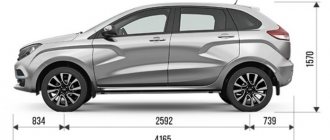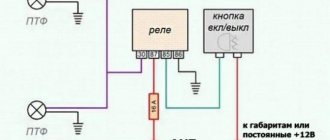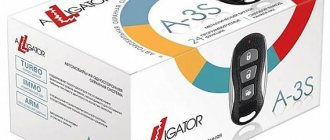Many people are mistaken and think that AvtoVAZ gives a guarantee of 3 years of operation or 100 thousand km. I drive a Lada Vesta, so I will talk about AvtoVAZ. People think that you can drive 100 thousand and not worry. But that's not true. If you think that if you have a knock somewhere and the dealer will immediately replace the spare part for you, then you are mistaken. Therefore, I decided to find out how long the warranty for Vesta is.
The timing belt pulley on my car flew off and started making noise. So I re-read the warranty card and found out that the warranty period for it is zero. Below I’ll explain what’s going on. I called the dealership and asked if this roller was covered under warranty. They said no.
Some advisers say that the timing belt can become stiff in the cold and make such sounds. But the temperature outside is above zero. Even when I drove in severe frost, the belt did not make any sounds.
For cars of the Lada Vesta family, the manufacturer…
...initially I planned to provide a longer and more extensive warranty than for Grant and Kalina. But ultimately it remained the same as its predecessors, and is 36 months or 100 thousand kilometers, whichever comes first. This means that if you actively use the car and can drive it 100 thousand in a year, your warranty will end there, even though 36 months have not yet passed. During the warranty period, the plant undertakes to eliminate any malfunctions at its own expense, if the need arises.
Oil leak
! The presence of oil on the surface of the shock absorber rod or body is not always a sign of malfunction.
- The shock absorber rod is coated with a special preservative for long-term storage. The preservative is also pumped into the oil seal. After the first movements of the rod and contact with the oil, the preservative coagulates, forming drops similar to drops of oil. And after several hours of operation of the shock absorber, the preservative should evaporate. Excess preservative may leave imprints on the surface of the package or visually resemble shock-absorbing fluid on the shock absorber rod.
- The hydraulic twin-pipe shock absorber contains special technological holes for bleeding off excess oil resulting from increased pressure inside the shock absorber. In this case, a leak may form on the body (but not on the rod) of the shock absorber. The norm is considered to be a level of oil leakage up to 1/3 of the height of the shock absorber body.
- All other cases of leakage should be considered as a possible result of shock absorber failure. In this case, the check should be more thorough and carried out by specialists from the service center that installed the shock absorber.
Warranty cases, or when should I contact service?
The warranty for the Lada Vesta begins from the moment the new car is handed over to its first owner. It is only provided if the damage or malfunction is not the fault of the driver. Confirmation that the owner adhered to the operating criteria is the timely completion of technical inspection. Documents about this must be kept in order to be able to provide them if necessary and receive free repairs under warranty.
You can troubleshoot problems by contacting an official service center. A specialist must inspect the car and identify faults. Only on the basis of the expert’s conclusion will the official dealer make a decision on repair or replacement of components.
Some elements of the Vesta car have factory defects. These include sticking door handles, an external antenna falling off due to overtightening, non-functioning turn signals and heated glass. The manufacturer is aware of these shortcomings and carries out warranty replacement of these components without problems.
Returns before and after 15 days
Let's consider the procedure for returning a car to the dealership almost immediately after purchase. First of all, you must write a claim in two copies and submit it before the expiration of the fifteen-day period.
The countdown begins from the next day of purchase and start of use of the car. The salon representative must leave his signature on your copy of the application. You will need to wait no more than 10 days for a refund. If after this time the money has not been returned to you, then you have the right to receive a penalty. If you continue to be ignored, then you need to go to court.
If 15 days have expired, then the procedure must also begin with writing a claim. Here the dealer may delay the examination procedure and may try to blame you for the vehicle malfunction. The claim must also be sent to the salon itself so that the examination is not carried out at your expense.
You can and even must be present during the inspection. If you are not satisfied with the result obtained, you can conduct your own independent examination.
What documents are required to obtain a guarantee?
When contacting the service center with a problem, the vehicle owner must have the following documents with him:
- Warranty card;
- Service passport;
- Registration document;
- Driver's license (if necessary).
In addition, he must provide evidence that he has carried out a scheduled technical inspection and a separate inspection of the body elements, during which the presence or absence of corrosion or other defects in the paintwork is checked. It is necessary to undergo a body inspection, otherwise the warranty will not apply to it.
Related link:
Reviews from car owners - Lada Vesta
Also, Lada Vesta owners need to know that if a malfunction occurs that makes it impossible to move the car, they have the right to call a tow truck, which will be paid for by the manufacturer if the warranty decision is positive.
Signs of clutch failure
The occurrence of malfunctions in the Vesta clutch mechanism is most often associated with improper operation (inexperience of the driver, aggressive driving style), an initial defect in the part, or breakdown of other components interacting with it. Of course, you will immediately notice problems with the clutch - the car will begin to behave differently:
- Gears are difficult to shift/do not work at all;
- Pedal too soft/hard;
- The car jerks;
- The device is activated in the upper position of the pedal.
There can be many reasons for this behavior of Vesta, and not all of them are related to the intermediate part between the internal combustion engine and the gearbox. Often the problem comes from the fluid system. There may be a malfunction of the brake master cylinder, clutch slave cylinder, damaged hoses, a simply low DOT4 level or an air lock. Such problems (especially problems with the cylinder of the unit) have exactly the same effect as the failure of the entire unit. The clutch consists of a housing cast together with the drive/pressure plate (basket) and the driven disc. The release bearing of the Lada Vesta acts on the petals of the basket, which, in turn, with the help of damper springs, press the inner disk away from the flywheel - the clutch opens. The bearing moves either under the influence of the hydraulic pedal drive (manually) - manual gearbox, or from the actuator (automatically) - manual gearbox. These parts can fail: more often - the release mechanism, less often - the basket body. Let's take a closer look at the most common “breakdowns”.
Warranty periods for individual vehicle components and mechanisms
In addition to the warranty of the car itself, the factory provides special service life for its individual parts. This is due to the specifics of their work and the load they are exposed to during movement.
Special terms of the manufacturer’s obligations are provided for the following parts of the Lada Vesta:
| Car detail | Guarantee period |
| Body parts (through corrosion) | 6 years |
| Front strut bearings (supports) | 1 year or 35 thousand km |
| Accumulator battery | 2 years |
| Shock absorbers (front and rear) | 2 years or 40 thousand km |
| Clutch parts (discs, clutch release) | 3 years or 30 thousand km |
| Suspension parts (steering joints, bushings and stabilizer struts, ball joints, rubber and metal silent blocks, etc.) | 3 years or 50 thousand km |
| Exhaust system (mufflers, resonators, catalysts and sensors) | 1 year or 35 thousand km |
AvtoVAZ provides special conditions for cars equipped with gas equipment, such as Lada Vesta CNG. The warranty period for LPG, which is present on the car from the factory, is 2 years.
Consumable parts such as brake pads, gearbox and engine oil, brake fluid, wiper blades, fuses, filters, spark plugs, lamps and more are not guaranteed. They are changed by the owner independently if the need arises.
First maintenance
List of first maintenance (15,000 km or a year of car operation)
1. Changing the oil in the internal combustion engine. 4.4 liters oil volume in Lada Vesta with manual transmission. A car with an automated manual transmission requires 3.2 liters. The manufacturer recommends using ROSNEFT Maximum 5W-40 engine oil; the cost for a 4-liter canister will be approximately 700 rubles.
2. Replacing the oil filter. Prices start from 250 rubles.
Necessary checks during each maintenance:
- wheel alignment;
- steering rack;
- checking for steering wheel play;
- car brake system connections;
- brake pads, discs and drums of wheel brake mechanisms;
- vacuum cleaner;
- checking the hand brake;
- crankcase ventilation system;
- implementation of cooling supply;
- antifreeze supply;
- exhaust system check;
- gasoline supply system to the engine;
- checking the suspension of the front part of the car for wear;
- checking the rear suspension of the car for wear;
- tire check;
- brake fluid;
- checking for rupture and stretching of the timing belt;
- battery;
- spark plug;
- adjusting the angle of low and high beam headlights;
- cleaning the car's drainage system.
When can a manufacturer refuse a warranty?
The manufacturer of the Lada Vesta car clearly states the terms of the warranty and the reasons why it may refuse free service.
Failure may occur for one of the following reasons:
- Use of unsuitable (not recommended by the factory) lubricants and other consumables;
- Failure to eliminate (or untimely elimination) faults that were detected by the official service and led to other breakdowns;
- Carrying out repair work at non-certified service stations;
- Independent installation of any equipment, changes in software, any re-equipment of the vehicle by employees not authorized by AvtoVAZ;
- Mechanical damage to the body: dents, scratches, abrasions that arose during operation. The plant is not responsible for damage resulting from an accident, the actions of intruders, falling heavy objects, natural disasters, military operations, etc.;
- Exposure to the paintwork of chemicals: road surface reagents, bitumen stains, any substances of plant and animal origin;
- Damage caused by careless driving.
Related link:
Owner reviews about Lada Vesta CNG.
The 6-year corrosion-free guarantee applies only to car body parts. The appearance of rust or arbitrary deformation on chassis parts, brackets and exhaust system elements is not subject to warranty.
Repair not from an authorized dealer
No automobile manufacturer will be held responsible for a car that was not repaired using factory technology and using unknown equipment.
The owner whose car is under warranty service must not:
- Perform servicing of parts or repair of any breakdowns not at an authorized dealer, but at any other station.
- Fix problems yourself, even if there was no other option.
- Purchase spare parts and consumables of unofficial origin.
- Buy spare parts or consumables not from a dealer, but from any other place.
Reviews from Lada Vesta car owners about the factory warranty
| Positive | Negative |
| I have a problem with the LED repeaters on the mirrors. They turned out to be leaky, and within a year they began to work poorly. When I contacted the service, to be honest, I thought that they wouldn’t change it, since the optics were not covered by the warranty. But the failure was recognized as covered by warranty, and both mirrors were replaced. True, we had to wait until the desired color was delivered. | After a year of use, severe scratches began to appear on the side glass of my Vesta. Apparently, the rubber seals fit too tightly to the glass and scratch it. When contacting the service, they said that this does not affect visibility and the integrity of the glass is not compromised. Even though there was a manufacturing defect, they refused to replace the glass. |
| I contacted the service center once. The stabilizer bushings creaked loudly. The specialists checked this by rocking the car on a special device, and immediately replaced it with new type bushings. I've been driving for the second month, nothing squeaks. | When purchasing a car, you carefully studied what the warranty covers. They promise 6 years on paintwork, but they forget to say that it is necessary to undergo a body inspection, separately from general maintenance. If it is not passed, the warranty is void. The service workers told me this in confidence, otherwise I wouldn’t have known. |
| My door handles started sticking about six months after purchase. During the next maintenance, the masters themselves noticed this and ordered me new pens for free. I was pleasantly surprised by the service! | I wanted to take the Lada Vesta, but when I found out how long the warranty was, I immediately changed my mind. Why only three years!? All competitors, for example Kia Rio, have been giving 5 years for a long time and working without breakdowns for the entire period and much more. AvtoVAZ’s quality is already not up to par, and the warranty is ridiculous! |
| It's a budget car, so there are a lot of minor problems with it. We have normal service at a certified station in Tyumen, and all complaints are considered. Recently they replaced my antenna free of charge, the mount was falling apart while moving. | After 30,000 km, a lot of problems emerged with Vesta. The AMT is humming, the handbrake cable does not hold, the pump is leaking, there are some strange knocks on the doors. At the office the station said that this was how it should be, they added oil (at my expense, by the way) and that’s it. What kind of guarantee is this? There are only problems with this car; it is still very far from foreign cars! |
Related link:
Changing the gearbox oil on a Lada Vesta.
Reviews taken from the sites: https://Lada.online, https://www.zr.ru, https://vesta-site.ru, https://www.lada.ru.
Transmission noise
A noise is heard from the gearbox, a small knock that disappears when you press the clutch pedal.
There are 2 misconceptions:
- The release bearing hummed. But it shows itself only at the moment the pedal is pressed, when the load on the clutch bearings begins.
- The input shaft bearing is humming. This is also incorrect, since SKF bearings have been installed on VAZ boxes for many years. There is practically no marriage on them.
In fact, the culprit of the knock is the clutch driven disc, namely its central bushing.
It has play in the seat. During torsional vibrations at idle, a fractional knock appears. The problem is solved by installing new clutch discs.
conclusions
The warranty period for the Lada Vesta car is only 3 years or 100 thousand kilometers. Compared to Korean and European competitors, this is very little, since most of them offer a warranty of 5 years or 150 thousand km. A 6-year warranty is provided only for body parts that must not have undergone through corrosion during this period.
In most cases, the manufacturer carries out service repairs without any problems and makes the necessary replacement of spare parts. The car owner is only required to undergo scheduled maintenance on time and use oils and other technical fluids recommended by AvtoVAZ. Many of the shortcomings that new Lada cars suffer from are corrected by official representatives free of charge.
The use of hydraulic shock absorbers in difficult temperature conditions
- The shock-absorbing fluid in all series of KYB shock absorbers is guaranteed to maintain operating parameters in the ambient temperature range from +80°C to -25°C, which corresponds to the performance of the original parts.
- At low temperatures (below -25°C), the viscosity of the shock-absorbing fluid increases. But this affects the quality of work only in the first meters of driving, since the shock absorber generates a large amount of heat, which brings the fluid to its operating temperature very quickly.
- In this regard, during frosty periods it is recommended to drive at a low speed (no more than 3 km/h) for the first 500 meters after parking the car in order to bring the shock absorbers into operating mode and protect their valve system from water hammer.
Conditions that must be met for the
- Timely mandatory maintenance at the services of an official dealer.
- It is mandatory to have a service book and a warranty card for inspection or repair.
- Compliance with the operating instructions.
- No changes were made to the design of the car, factory settings, parameters of electronic units, etc. not at the dealer's service.
- Repairs and maintenance were carried out only at the official Lada service center.
- Only high-quality gasoline and original consumables were used.
Insurance crash test
When dealing with minor collisions, a crash test would seem to be inappropriate, but that is not the case. The fact is that there is a so-called “insurance crash test”, or a crash test according to the Danner method. It is with its help that the cost of minor repairs to the model is estimated. It was conducted by AutoReview journalists.
It is carried out at a special training ground, but the acceleration speed of the car is only 15 km/h. At the same time, the sedan hits a 40 percent overlap - its role is played by an indestructible barrier located at an angle of 80° in relation to the longitudinal axis of the car. Naturally, they hit the car on the driver's side.
Such an event allows us to simulate a common situation in a big (and not only) city, when the owner of a Vesta collides with a car driving in front. In this case, the MTPL policy will allow you not to worry about compensation for the owner of the second car, however, if the owner of Vesta does not have a CASCO policy, he will have to pay for the repairs out of his own pocket.
The Lada Vesta insurance crash test itself took place back in December 2016, but there are no significant differences in terms of prices for spare parts and labor. The only significant advantage is that you don’t have to wait several weeks for spare parts. In addition, conducting this “bumper test” will allow you to compare its results with similar tests by X-Ray and see which of the 2 models turned out to be more successful.
The LADA Vesta insurance crash test is clearly demonstrated in the video.











